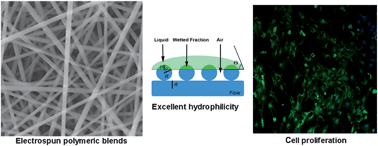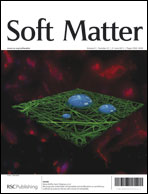The objective of this study is elucidating the mechanisms by which the wettability of nanofibrous electrospun mats varies in polymer blends, and highlighting how this can play a pivotal role in enhancing the viability of cultured microvascular endothelial cells (EC). A functional microvascular network is essential for supplying bioengineered tissues with oxygen and nutrients while removing metabolic wastes. An in vitro pre-vascularization strategy consists of seeding EC on scaffolds, which in turn promotes cells infiltration, adhesion and functionality. We use electrospun poly-L-lactic acid (PLLA) and gelatin (Gel) as prototype materials for realizing nanofibrous scaffolds as bioartificial architectures to improve the proliferation and the functionality of human microvascular ECs (HMEC-1). HMEC-1 seeded on electrospun scaffolds adhere, remain viable, proliferate and positively express the endothelial cell marker CD31 particularly on blend PLLA/Gel fibers, which exhibit wettability enhanced with respect to both the constituent polymers, and are therefore especially promising constructs for promoting the formation of functional endothelial tissue. The wettability characteristics of the blend polymer fibrous scaffolds are modeled and discussed. These results can be valuable for the future design of pre-vascularized scaffolds with enhanced wettability properties for functional tissue engineered implants, with ECs able to form in perspective an effectively functioning vasculature upon implantation.

You have access to this article
 Please wait while we load your content...
Something went wrong. Try again?
Please wait while we load your content...
Something went wrong. Try again?


 Please wait while we load your content...
Please wait while we load your content...